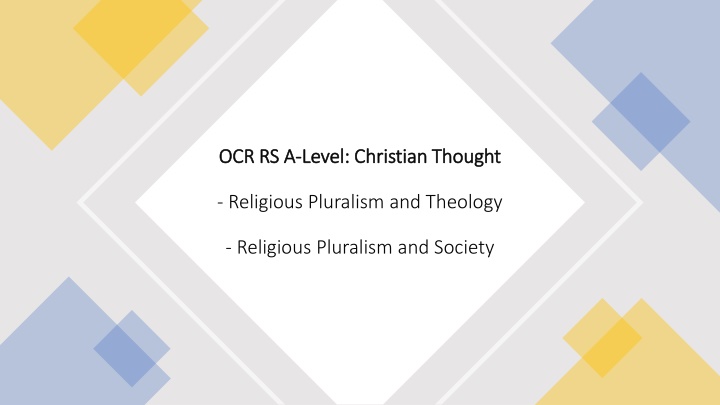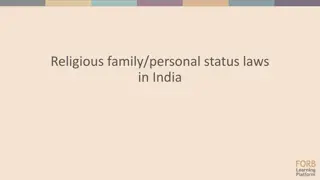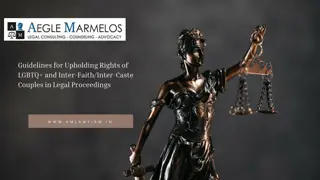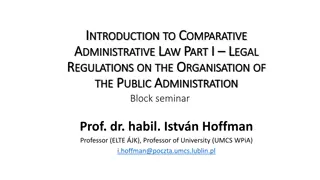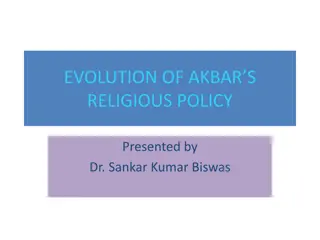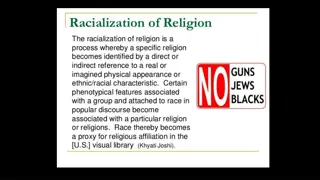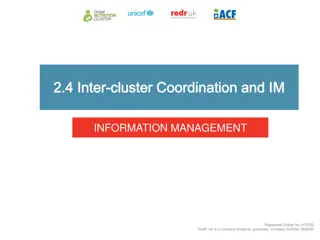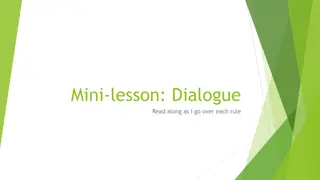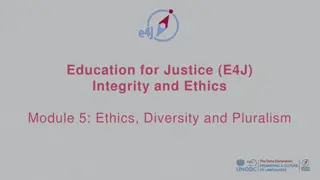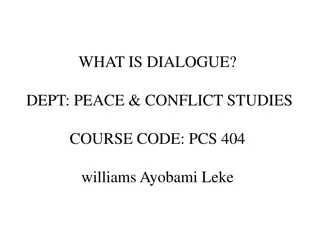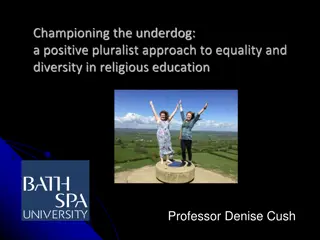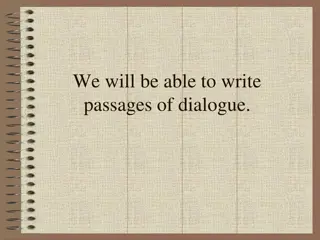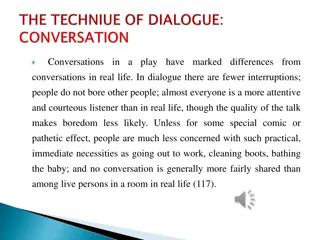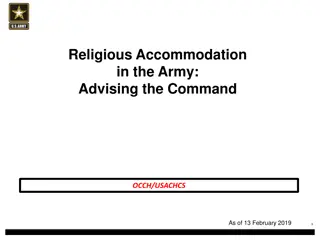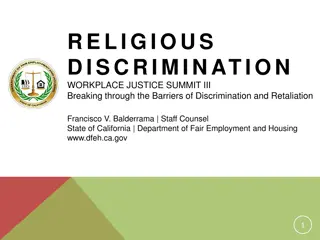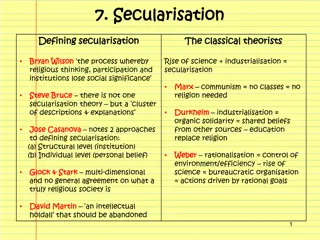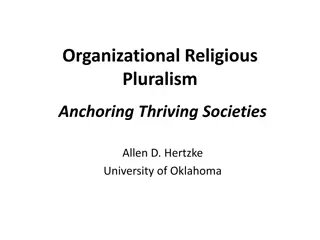Inter-faith Dialogue and Religious Pluralism
Inter-faith dialogue involves people of different religious beliefs engaging to foster mutual respect, peace, and understanding. It is not about conversion but seeking commonalities amidst differences. Various initiatives like Dabru Emet and A Common Word Between Us and You highlight the importance of collaboration for peace and coexistence
Download Presentation

Please find below an Image/Link to download the presentation.
The content on the website is provided AS IS for your information and personal use only. It may not be sold, licensed, or shared on other websites without obtaining consent from the author.If you encounter any issues during the download, it is possible that the publisher has removed the file from their server.
You are allowed to download the files provided on this website for personal or commercial use, subject to the condition that they are used lawfully. All files are the property of their respective owners.
The content on the website is provided AS IS for your information and personal use only. It may not be sold, licensed, or shared on other websites without obtaining consent from the author.
E N D
Presentation Transcript
OCR RS A OCR RS A- -Level: Christian Thought Level: Christian Thought - Religious Pluralism and Theology - Religious Pluralism and Society
Past paper Past paper questions questions
INTER FAITH DIALOGUE - Catholic - Church of England Religious Pluralism and Society
Inter-faith dialogue is about people of different religious beliefs coming together and trying to develop a deeper understanding of each other s faith. It includes talk about beliefs religions hold in common and where they differ. Inter-faith dialogue It is not about trying to convert people from one faith to another or demonstrating that one belief system is superior to another. It allows religious people to come to a deeper understanding of their own faith, while learning about and from the beliefs of others.
Inter-faith dialogue Inter-faith dialogue is about people of different religious beliefs coming together and trying to develop a deeper understanding of each other s faith. Holocaust led to an effort at inter-faith dialogue initiated by Jewish rabbis called Dabru Emet Speak the truth . It highlighted that Christians and Jews share the same God, scriptures and needed to work together for peace. It includes talk about beliefs religions hold in common and where they differ. Twin Towers led to an effort at inter- faith dialogue initiated by Muslim scholars called A Common Word Between Us and You . It highlighted that Muslims and Christians both worship one God and put love for one s neighbours in practice. It is not about trying to convert people from one faith to another or demonstrating that one belief system is superior to another. It allows religious people to come to a deeper understanding of their own faith, while learning about and from the beliefs of others.
Religious Pluralism and Society INTER FAITH DIALOGUE - Catholic
Redemptoris Missio: The Mission of the Redeemer It is a Papal encyclical, written by the St John Paul II, Pope in 1990, that addresses the place of Christian missionary work in a multi-faith world. Redemptoris missio (Latin for The Mission of the Redeemer), subtitled On the permanent validity of the Church's missionary mandate, is an encyclical by Pope John Paul II published on 7 December 1990. The release coincided with the twenty-fifth anniversary of Vatican II's Decree on the Church's Missionary Activity, Ad gentes. It is devoted to the subject of "the urgency of missionary activity and in it the pope wished "to invite the Church to renew her missionary commitment." Redemptoris Missio 55 57
Religious Pluralism and Society INTER FAITH DIALOGUE - Church of England
The Church of England and inter- faith dialogue: Sharing the Gospel of Salvation . In 2006 Paul Eddy asked the Synod of the CofE where the CofE felt it stood on the question of whether or not it should be trying to convert people of other faiths to Christianity. He thought Christians had become too fearful of giving offence, to the extent that they no longer proclaimed that Jesus was the way to salvation, but instead kept quiet and went along with the idea that everyone should be free to have their own beliefs and not be challenged. The document Sharing the Gospel of Salvation came about as an outcome of this discussion and was published in 2010.
Religious Pluralism and Society SCRIPTURAL REASONING MOVEMENT
What is Scriptural Reasoning? Scriptural Reasoning is a practice of inter-faith reading where people of all faiths gather and reflect on short passages from their scriptures together. Textual reasoning was a university-based forum for scholars of Modern Jewish Philosophy and scholars of Rabbinic texts to meet and study together. The aim was to grow in understanding of the different disciplines, and to approach key questions about Judaism in the present and future. In the mid 1990's, some Christian friends of members of the Textual Reasoning group sat in on the conversation, and were so attracted by the lively process that they suggested using it as a model for inter-faith conversations. Later, Muslim friends were invited to join the conversation, and 'Scriptural Reasoning' was born. The first Christian participants were from the UK, and the practice quickly spread across the Atlantic. Before long, it also began flourishing among non-academic groups. It is a worldwide movement www.scripturalreasoning.org recently started in Oxford.
Scriptural Reasoning Reading, listening to and reflecting on scripture is something many do naturally within their own worshipping communities. Participants in SR are not asked to leave that behind; rather, people of different faiths come together to read and reflect on their scriptures side-by-side. SR is not about seeking agreement but rather exploring the texts and their possible interpretations across faith boundaries, and learning to disagree better . The result is often a deeper understanding of others' and one s own scriptures, as well as the development of strong bonds across faith communities. SR is now practised globally, including in places affected by religion-related tensions and conflict.
1. Participants identify a narrative or theme, perhaps a concern or issue arising from their community or their context. 2. Each faith community selects a short passage from their scripture relating to that theme. How does it How does it work? work? 3. Participants meet in small groups and one at a time, each passage of scripture is read out loud to the rest of the group. Others may never have come across it before so they give an 'introduction', explaining a little of its context in the scripture and its importance in the faith tradition. 4. Convened by a facilitator, participants then discuss the passages one at a time- they may begin by asking questions to help them understand it better, or share a reflection or something that particularly strikes them as they hear it. In this way, an open and interactive discussion begins and the participants are able to reflect together on the possible meanings of the text.
What's the outcome? What's the outcome? Learning and understanding- Participants learn more about other faith communities through what is often at their heart- scripture. In addition to a deep inter-faith encounter, SR deepens peoples' understanding of their own scripture and wider tradition. This is because you read your text in the company of someone outside your tradition who may not have read your scripture before, and who sees it through very different lenses to your own. As a result of their questions and reflections, participants' relationships with their own scripture is enriched. Exploring differences- SR allows us not only to appreciate the many things which we share and have in common, but it also draws on differences and teaches participants to appreciate them. There is no pressure to come to an agreement or consensus, and differences and questions are as welcome as similarities and answers. SR may of course find common ground, but it can also be content to improve the quality of our disagreements . Friendships- With time, as relationships between members of the group grow, traditional stereotypes of the other are broken down, barriers are dismantled and at best, participants develop lasting friendships underpinned by an appreciation of difference as well as an understanding of common values. Deep and sometimes risky friendships develop across divides. Participants may, together, draw on the wisdom of their different traditions to deal with the practical issues their communities face and their ability to respond together is strengthened.
